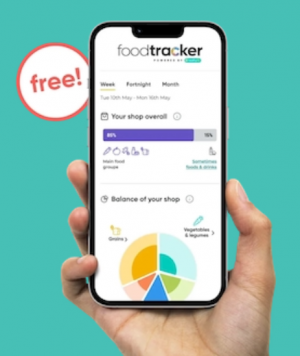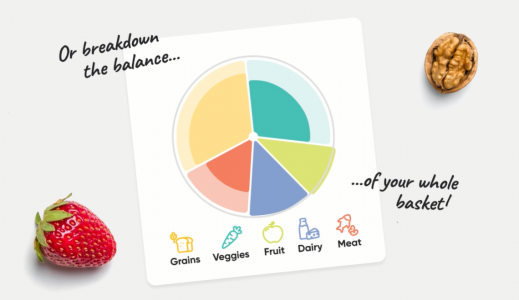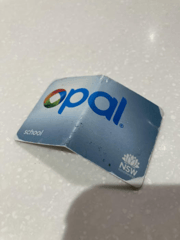Woolies reveals new feature that will change the way you shop!
- Replies 9
We are always keen to hear about innovations that make our lives easier, and grocery shopping is one area where there's always room for improvement.
After all, it's something we have to do every week (or at least every few weeks), so anything that makes the process quicker and more efficient is a welcome addition in our books!
That's why we were excited to hear Woolies latest announcement: a brand-new feature called the Food Tracker, which has been designed to help customers make healthier choices while doing their weekly shop.
The tracker, developed with HealthyLife, is a free tool found in their Everyday Rewards app’s ‘Discover’ tab.
The new feature analyses your shopping habits and compares them against Australia's healthy eating guidelines.
Woolies’ Food Tracker does this by looking at how much of your groceries count as ‘main group’ foods — such as fruit and veg, meat, dairy — and as ‘sometimes foods’ like sugary snacks or junk food.
Based on this information, you will have an overview of items you need more and less of in your shopping cart or basket.

‘With summer just around the corner, we know many Aussies are thinking more about their health and well-being, as well as how they will achieve a balance in their eating habits during what is typically an indulgent season of festive celebrations,’ said HealthyLife Chief Health Officer Simone Austin.
‘With the launch of the HealthyLife Food Tracker on the Everyday Rewards app, we are providing customers with a convenient way to compare their individual shopping purchases to the Australian Guide To Healthy Eating.’
The guide recommends eating from five food groups every day, namely: grain, lean meats and poultry, fruit, dairy products like milk, yoghurt, cheese, and vegetables.
‘This tool is a first globally as it compares shopping data against servings suggested in the dietary guidelines.’ Austin said.
The Food Tracker also details how many potential food servings are in the food items customers buy, ranging from a one-person household size to servings fit for a family.
‘Anyone doing their weekly or monthly shop with the tracker can see at a glance what food groups they could buy less of and if they need to add more foods like fruit, veggies and grains to provide enough healthy meals and snacks for their household.’ Austin pointed out.
So for example, if you regularly buy large quantities of ‘sometimes foods’, the Food Tracker might suggest purchasing smaller amounts or opting for healthier alternatives next time you're shopping at Woolies.

Alternatively, if you don't seem to be buying enough fruit and vegetables each week, it will give you some suggestions on how you can incorporate more healthy items into your diet.
And as a bonus, that voice in your head telling you to put that delicious processed food item back on the store shelf won’t have to do much work anymore, because the tracker will be doing the talking. Kidding!
The Woolworths Group acquired HealthyLife in 2021 to expand its health and wellness portfolio.
Now, of course, we can’t always rely on an app to do our healthy grocery shopping for us, right?

One quick way to gauge if an item is good for you or not is to look at its nutrition label. The label shows the item’s nutrient contents, including but not limited to proteins, fats, carbohydrates, sodium, and sugars.
If you’re thrown off by the many details on nutrition labels, don’t worry, we get you! The numbers and small letters do tend to be confusing.
Luckily for all of us, the government has an interactive guide we can use here.
Meanwhile, you could also check out why eating a rainbow (you read that right!) is said to be a great way to improve health.
You may also want to look at these easy tips from a nutritionist on how to eat more healthy foods without keeping in mind complicated diet instructions.
So, what is your reaction to Woolies’ new Food Tracker feature? Is it something you see helping you shop, or do you prefer doing things the old, tech-less way?
Tell us your thoughts and opinions below!
Source: YouTube/Edith Cowan University
After all, it's something we have to do every week (or at least every few weeks), so anything that makes the process quicker and more efficient is a welcome addition in our books!
That's why we were excited to hear Woolies latest announcement: a brand-new feature called the Food Tracker, which has been designed to help customers make healthier choices while doing their weekly shop.
The tracker, developed with HealthyLife, is a free tool found in their Everyday Rewards app’s ‘Discover’ tab.
The new feature analyses your shopping habits and compares them against Australia's healthy eating guidelines.
Woolies’ Food Tracker does this by looking at how much of your groceries count as ‘main group’ foods — such as fruit and veg, meat, dairy — and as ‘sometimes foods’ like sugary snacks or junk food.
Based on this information, you will have an overview of items you need more and less of in your shopping cart or basket.

Woolies is offering shoppers a chance at healthier food choices with its new Food Tracker feature in its Everyday Rewards app. Credit: HealthyLife
‘With summer just around the corner, we know many Aussies are thinking more about their health and well-being, as well as how they will achieve a balance in their eating habits during what is typically an indulgent season of festive celebrations,’ said HealthyLife Chief Health Officer Simone Austin.
‘With the launch of the HealthyLife Food Tracker on the Everyday Rewards app, we are providing customers with a convenient way to compare their individual shopping purchases to the Australian Guide To Healthy Eating.’
The guide recommends eating from five food groups every day, namely: grain, lean meats and poultry, fruit, dairy products like milk, yoghurt, cheese, and vegetables.
‘This tool is a first globally as it compares shopping data against servings suggested in the dietary guidelines.’ Austin said.
The Food Tracker also details how many potential food servings are in the food items customers buy, ranging from a one-person household size to servings fit for a family.
‘Anyone doing their weekly or monthly shop with the tracker can see at a glance what food groups they could buy less of and if they need to add more foods like fruit, veggies and grains to provide enough healthy meals and snacks for their household.’ Austin pointed out.
So for example, if you regularly buy large quantities of ‘sometimes foods’, the Food Tracker might suggest purchasing smaller amounts or opting for healthier alternatives next time you're shopping at Woolies.

Customers can compare their food choices to guidelines presented by the Australian Government for healthy eating with the Food Tracker feature. Credit: HealthyLife
Alternatively, if you don't seem to be buying enough fruit and vegetables each week, it will give you some suggestions on how you can incorporate more healthy items into your diet.
And as a bonus, that voice in your head telling you to put that delicious processed food item back on the store shelf won’t have to do much work anymore, because the tracker will be doing the talking. Kidding!
The Woolworths Group acquired HealthyLife in 2021 to expand its health and wellness portfolio.
Now, of course, we can’t always rely on an app to do our healthy grocery shopping for us, right?
Key Takeaways
- Woolworths launched a new Food Tracker feature in its Everyday Rewards app.
- The tracker, developed in partnership with HealthyLife, allows customers to get an overview of how healthy their Woolies purchases are by using government guidelines on healthy eating.
- The Food Tracker can also suggest ways Woolies shoppers can tweak their shopping items for a healthier haul to take home.
If you’re thrown off by the many details on nutrition labels, don’t worry, we get you! The numbers and small letters do tend to be confusing.
Luckily for all of us, the government has an interactive guide we can use here.
Meanwhile, you could also check out why eating a rainbow (you read that right!) is said to be a great way to improve health.
You may also want to look at these easy tips from a nutritionist on how to eat more healthy foods without keeping in mind complicated diet instructions.
So, what is your reaction to Woolies’ new Food Tracker feature? Is it something you see helping you shop, or do you prefer doing things the old, tech-less way?
Tell us your thoughts and opinions below!
Source: YouTube/Edith Cowan University







